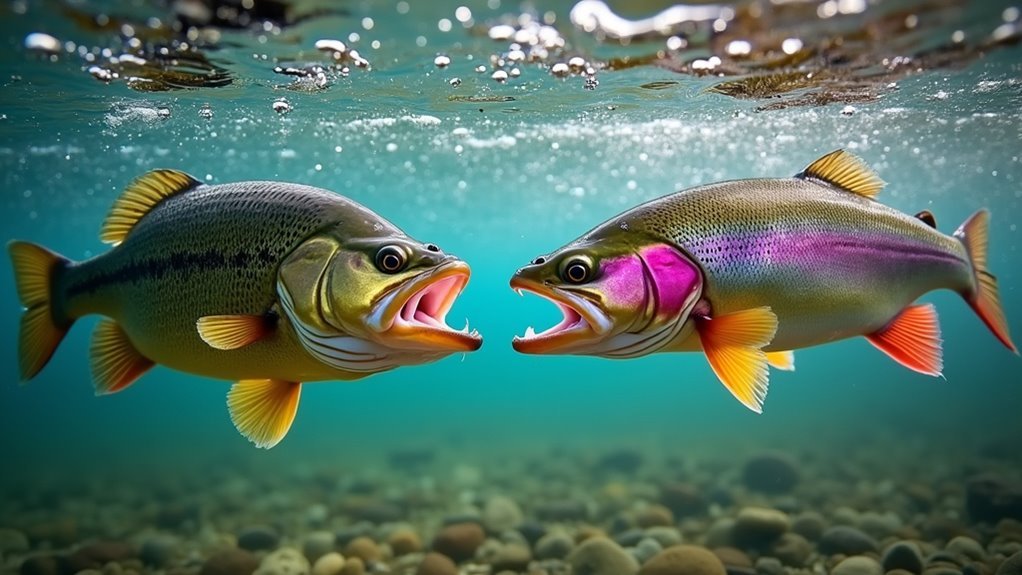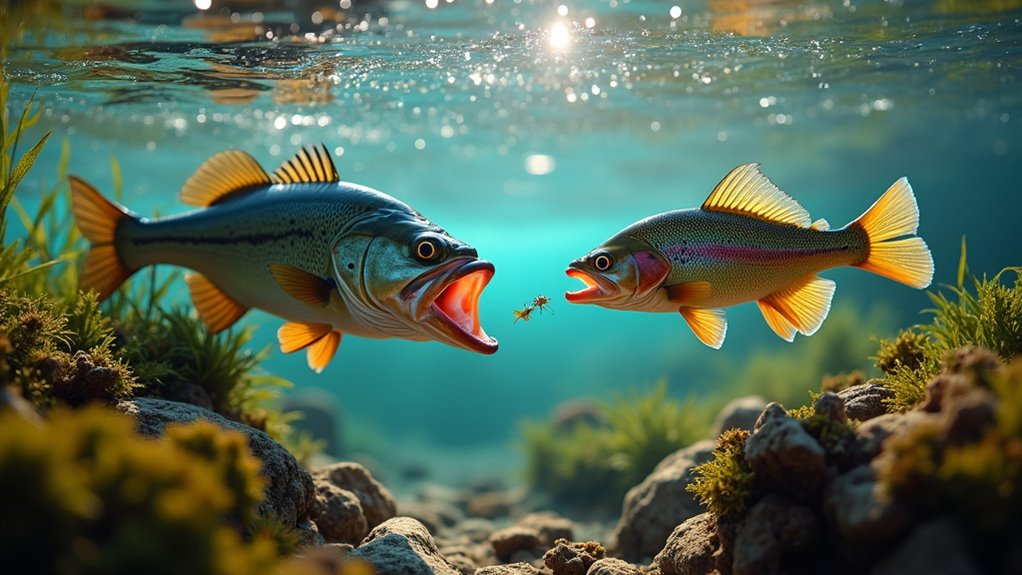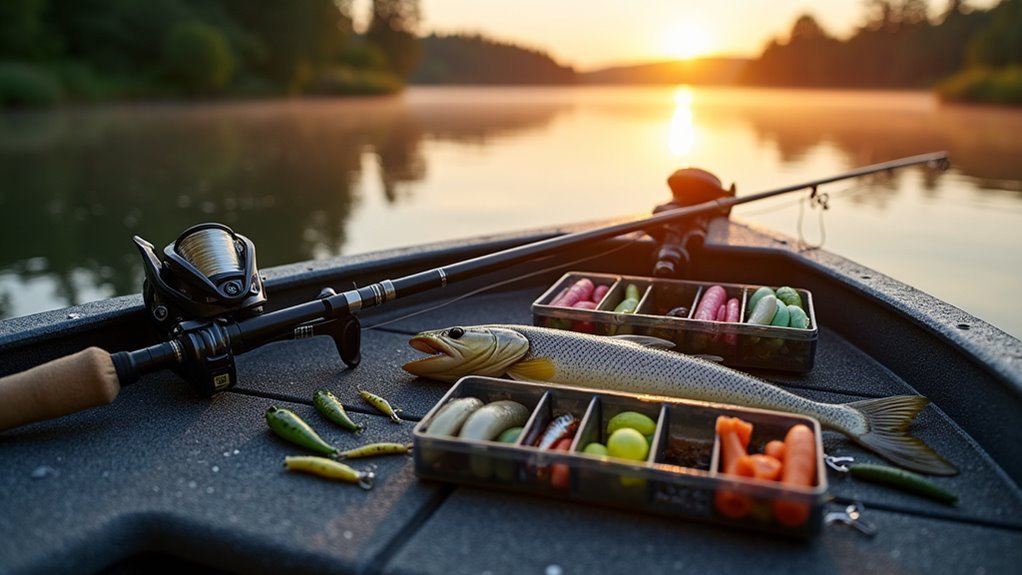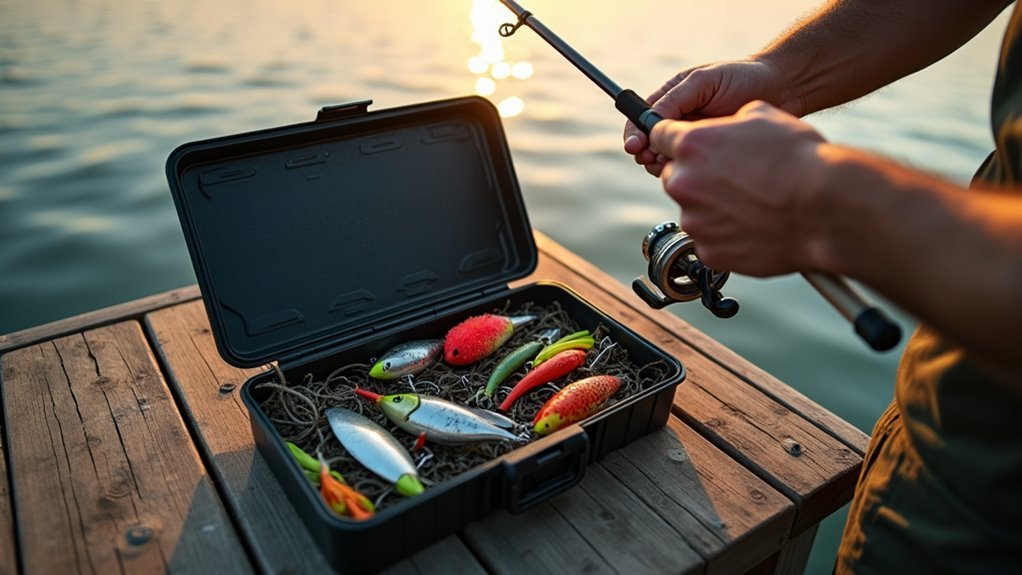Bass and trout offer completely different fishing experiences. We love bass for their aggressive fights in warm waters near vegetation, while trout challenge us with their pickiness in cold, clear streams. Your gear choices matter too—bass need heavier tackle for those chunky lures, but trout demand finesse with lighter equipment. Season by season, these freshwater rivals test different angling skills. I once caught a 5-pound smallmouth that fought harder than any fish twice its size!
The Battle of Freshwater Titans: Bass vs. Trout Characteristics

Anglers, gather ’round! Let’s plunge into what makes bass and trout such remarkable opponents in the fishing world.
Bass—particularly largemouth and smallmouth—are aggressive fighters that thrive in diverse environments. Largemouths prefer warmer, calm waters with cover, while smallmouths love cooler, moving currents. They’re opportunistic feeders that’ll strike at almost anything.
Trout, on the other hand, are the elegant dancers of cold, clear waters. They’re pickier eaters and more sensitive to environmental changes. I’ve found rainbow trout hitting spinners in mountain streams while lake trout hunker deep in summer’s heat.
Trout demand finesse and precision—nature’s connoisseurs slicing through crystalline currents with discerning appetites.
Each offers unique challenges worth pursuing! Additionally, understanding thrust power options can help you choose the right trolling motor for targeting these freshwater titans.
Habitat Preferences: Where to Find Your Target Species

While we dream of epic battles with trophy fish, success begins with knowing exactly where to find them in their watery homes. Bass and trout have distinctly different habitat preferences that’ll guide your next fishing adventure.
| Species | Water Type | Prime Locations |
|---|---|---|
| Largemouth Bass | Warm, still water | Vegetation, sunken logs, dock pilings |
| Smallmouth Bass | Cool, moving water | Rocky areas, stream edges, drop-offs |
| Trout | Cold, clear water | Deep pools, riffles, spring-fed streams |
Remember when I fished that mountain stream in Colorado? Found those beautiful rainbows hiding in shaded pools below small waterfalls—exactly where they should’ve been!
Feeding Patterns and Dietary Differences

Once you’ve found where your fish live, understanding what they eat becomes your next key to success. Bass and trout couldn’t be more different at the dinner table!
Bass are the opportunistic buffet-goers of the water. They’ll devour shad, bluegill, crawdads—pretty much anything that fits in their mouth. I’ve watched largemouth bass chase down ducklings!
Bass aren’t picky—if it moves and fits in their mouth, it’s on the menu.
Trout are pickier eaters. They primarily feed on insects, larvae, small baitfish, and crawfish. Water temperature drastically affects their appetite. Last summer, I caught a beautiful rainbow on a tiny midge pattern when nothing else worked.
Remember: match your lure to their natural food source!
Gear Selection: Matching Equipment to Your Quarry

Choosing the right fishing gear can make the difference between a successful day on the water and going home empty-handed. We’ve learned this lesson the hard way over years of chasing both bass and trout.
- Bass fishing typically demands heavier tackle—medium to heavy rods, baitcasting reels, and 10-17 pound test line to handle those powerful fighters around cover
- Trout call for finesse—ultralight to medium-light rods, spinning reels, and 4-8 pound test line for presentation-sensitive fishing
- Fly fishing equipment works wonderfully for trout and, increasingly, for bass too—just adjust your rod weight accordingly
Lure Selection and Presentation Techniques

Because bass and trout react to completely different stimuli, mastering your lure selection and presentation techniques for each species can transform your fishing success. We’ve found that bass respond well to larger, flashier presentations – think chunky crankbaits, noisy topwaters, and bulky jigs worked with confident movements.
Trout, on the other hand, prefer subtlety. They’re often spooked by aggressive retrieves. A gentle drift of a small spinner, a carefully presented fly, or a natural-looking salmon egg can make all the difference. I remember catching a monster rainbow on a tiny #16 midge pattern when everyone else was striking out with larger lures.
Seasonal Strategies for Both Species
Seasonal shifts dramatically change the game when targeting bass and trout throughout the year. We’ve learned that adapting our approach to each season is essential for consistent success on the water.
- Spring – Target bass in shallow spawning areas while fishing trout in higher elevation streams as snowmelt increases water flow
- Summer – Look for bass near deep structure during midday heat, while pursuing trout during cooler mornings and evenings in well-oxygenated waters
- Fall/Winter – Focus on slower retrieves for lethargic bass in deeper water, while trout become more active in lakes as temperatures drop
Frequently Asked Questions
Which Tastes Better: Bass or Trout?
We find trout generally tastes better than bass, with a delicate, sweet flavor. Trout’s flesh is tender and less fishy. Bass has a firmer texture and milder taste that some prefer. It’s ultimately personal preference.
Do Bass and Trout Ever Inhabit the Same Waters?
Yes, we’ll often find bass and trout sharing the same waters, especially in lakes and reservoirs. They typically occupy different zones though – trout prefer cooler, deeper waters while bass favor warmer, shallow areas.
Which Species Is More Challenging for Beginners to Catch?
Ever tried landing your first catch? We’d say trout are generally more challenging for beginners. They’re more cautious than bass, require more finesse in presentation, and they’re often less aggressive when feeding.
Can You Use the Same Fishing License for Bass and Trout?
In most states, we’ll need only one fishing license that covers both bass and trout. However, some areas require additional stamps or permits for trout fishing, so we should check local regulations before heading out.
How Do Catch-And-Release Practices Differ Between Bass and Trout?
We handle bass and trout differently during catch-and-release. Trout require gentler handling with wet hands as they’re more fragile, while bass are hardier but still need quick returns to water to survive.
Conclusion
We’ve explored both sides of this timeless debate, and truth be told, there’s no wrong choice. Last summer, we watched a fellow angler land a 6-pound bass at dawn and hook a stunning rainbow trout that evening—all on the same lake! Whether you’re drawn to a bass’s explosive power or a trout’s elegant fight, both offer incredible experiences. The real victory isn’t which you choose, but the unforgettable moments you’ll create on the water.